What is the meaning of the term germinate? to start growth to make eggs to store food to make sperm
Learning Objectives
- Compare and contrast the life cycles of angiosperms (flowering plants), gymnosperms (conifers), not-seed vascular plants (ferns), and nonvascular plants (mosses)
- Describe the structures and functions of the bloom, seed, and fruit in the flowering plant life cycle
- Explicate the process, locations, and significance of flowering plant gametogenesis and fertilization, including double fertilization
- Explain the process and significance of seed maturation, dormancy, and germination
- Predict mechanisms of pollination based on flower characteristics and dispersal based on fruit characteristics
Sexual reproduction in plants: Alternation of Generations
The text below is adapted from OpenStax Biology 32.1
Plants have two distinct multicellular stages in their life cycles, a phenomenon called alternation of generations(in contrast to thehaplontic and diplontic life cycles). These two stages are the multicellular, haploid gametophyte and the multicellular diploid sporophyte. This is very different from most types of animal reproduction where there is just one multicellular stage: a diploid organism which produces unmarried-celled haploid gametes.
Before we revisit this life wheel, a reminder of some terms:
- Gamete: a mature haploid male person or female germ cell that is able to unite with another of the opposite sex in sexual reproduction to form a zygote
- Spore: a minute, typically one-celled, reproductive unit capable of giving ascent to a new individual without sexual fusion
Gametes are ever haploid, and spores are usually haploid (spores are always haploid in the constitute alternations of generations life cycle).
In the alternation of generations life cycle, illustrated beneath, at that place is a mature multicellular haploid stage and a mature mulitcellular diploid stage. The multicelluar haploid stage (the gametophyte) produces gametes via mitosis which fuse to grade a diploid zygote. The zygote develops into a mature multicellular diploid individual (the sporophyte), which produces haploid spores via meiosis. The haploid spores then develop into a mature multicellular haploid individual.
Note the multicellular stages are named for what they produce, not what they come up from. The gametophyte makes gametes, and the sporophyte makes spores.
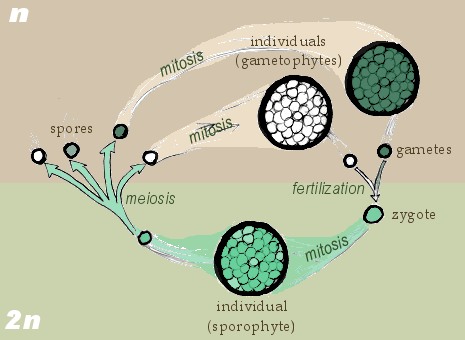
Alternation of Generations. Image credit: Menchi, Wikimedia Commons. https://en.wikipedia.org/wiki/File:Sporic_meiosis.png
Though all plants display an alternation of generations life cycle, there are meaning variations in unlike lineages of plants, consistent with their evolutionary history:
- In seedless non-vascular plants, orbryophytes (mosses), the haploid gametophyte is larger than the sporophyte (the plant structure that y'all see is the gametophyte); this is a gametophyte-dominated life cycle. The sporophyte is attached to and dependent on the gametophyte. (By "dominated" we mean "the phase of the establish yous can see by heart.")
- In seedless vascular plants (ferns), the sporophyte is larger than the gametophyte (the establish construction that you come across is the sporophyte), merely the gametophyte is free-living and contained from the diploid sporophyte.
- The life bike of angiosperms (flowering plants) and gymnosperms (conifers) is dominated by the sporophyte stage (the establish structure that you see is the sporophyte), with the gametophyte remaining attached to and dependent on the sporophyte (contrary of bryophytes).
- Though they both have sporophyte-dominated life cycles, angiosperms and gymnosperms differ in that angiosperms have flowers, fruit-covered seeds, and double fertilization, while gymnosperms practice not have flowers, have "naked" seeds, and practise not have double fertilization (more than on this later on).
The video below describes reproduction in gametophyte-dominant nonvascular plants (eg, mosses):
The video below describes reproduction in sporophyte-ascendant vascular plants (eg, gymnosperms and angiosperms):
Reproduction in angiosperms
The information beneath is adjusted from OpenStax Biology 32.ane
We'll expect more closely at reproduction in angiosperms, which are unique amidst plants for three defining features: they take flowers, they takefruit-covered seeds, and they reproduce via a process calleddouble fertilization.
- Flowers are adaptations to attractpollinators
- Fruits are adaptations to facilitateseed dispersal
- Double fertilization is an adaptation to invest resources for nourishment of the developing embryo, in a unique way compared to other plants
All the information below is specific to angiosperms, unless otherwise noted.
Flower Structure
A typical flower has iv "layers," illustrated and described below from external to internal structures:
- The outermost layer consists of sepals, light-green, leafy structures which protect the developing flower bud earlier it opens.
- The adjacent layer is comprised of petals, modified leaves which are usually brightly colored, which help attract pollinators.
- The third layer contains the male reproductive structures, the stamens. Stamens are composed ofanthers andfilaments. Anthers incorporate the microsporangia,the structures that produce the microspores, which go on to develop into male gametophytes. Filaments are structures that support the anthers.
- The innermost layer contains i or more female person reproductive structures, the carpel. Each carpel contains a stigma, mode, and ovary. The ovaries contain themegasporangia, the structures that produce themegaspores, which continue to develop into female person gametophytes. The stigma is the location where pollen (the male person gametophyte) is deposited by wind or by pollinators. The style is a structure that connects the stigma to the ovary.
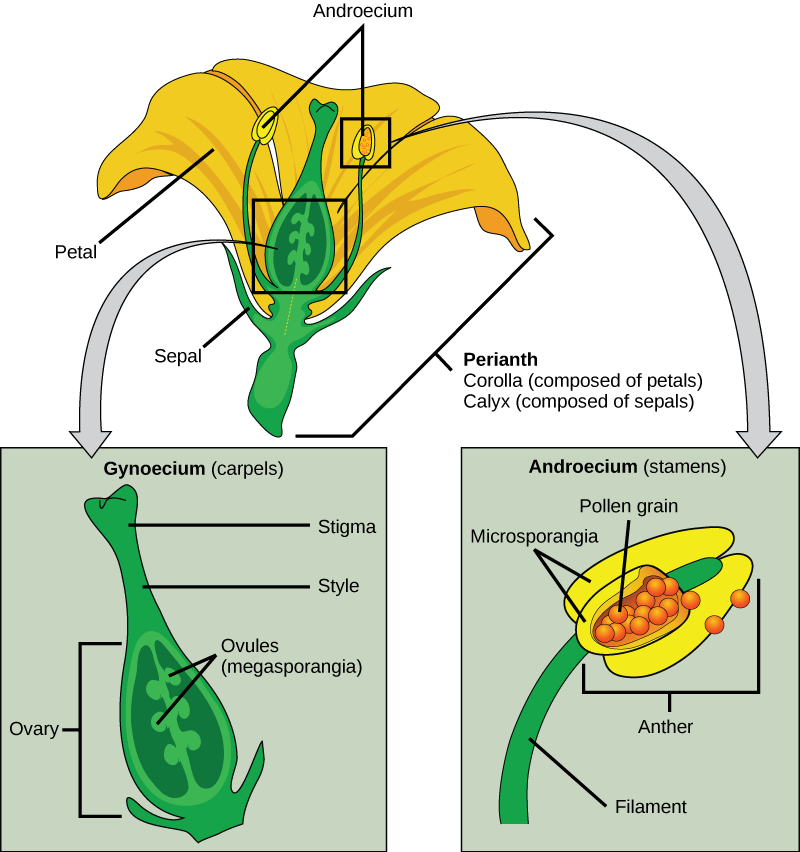
The parts of the flower include the sepal, petals, stamens, and carpels. Epitome credit: OpenStax Biology, modification of work past Mariana Ruiz Villareal
The Pollen Grain: the Male Gametophyte
Pollen is the male gametophyte in angiosperms and gymnosperms. Pollen is oftentimes described in everyday linguistic communication as institute sperm, only this is not the case! As the male gametophyte, pollen is a multicellular, haploid stage that produces the sperm.
Pollen development occurs in a construction called themicrosporangium(micro = modest), located inside the anthers. The microsporangia (plural of microsporangium) are pollen sacs in which the microspores develop into pollen grains.

Shown is (a) a cantankerous department of an anther at two developmental stages. The young anther (top) contains four microsporangia, or pollen sacs. Each microsporangium contains hundreds of microspore mother cells that will each requite rise to 4 pollen grains. The tapetum supports the development and maturation of the pollen grains. Upon maturation of the pollen (bottom), the pollen sac walls separate open and the pollen grains (male gametophytes) are released. (b) In these scanning electron micrographs, pollen sacs are ready to outburst, releasing their grains. Paradigm credit: OpenStax Biology; credit b: modification of work past Robert R. Wise; calibration-bar data from Matt Russell)
As a spore, the microspore is haploid, but information technology is derived from a diploid cell. Within the microsporangium, the diploid microspore female parent prison cell divides by meiosis to requite rise to four microspores, each of which volition ultimately course a pollen grain, illustrated below. This process is similar to production of gametes in animals (note that haploid gametes in plants are produced by mitosis from a haploid gametophyte). Upon maturity, the microsporangia burst, releasing the pollen grains from the anther where they take the opportunity to exist transported to stigmas by wind, water, or an animal pollinator.
Mature pollen grains contain two cells: a generative cell and a pollen tube cell (see, I told you pollen is multicellular!). The generative jail cell is contained within the larger pollen tube cell. When the pollen grain reaches a stigma, it undergoes a process calledgermination (which is not the same every bit seed formation). During pollen germination, the tube prison cell forms a pollen tube through the way to the lesser of the ovary, the generative prison cell migrates through information technology to enter the ovary for fertilization. During its transit inside the pollen tube, the generative prison cell divides to course two male gametes (sperm cells). Both sperm cells are required for successful fertilization in angiosperms.

Pollen develops from the microspore mother cells. The mature pollen grain is equanimous of 2 cells: the pollen tube cell and the generative jail cell, which is within the tube cell. The pollen grain has two coverings: an inner layer (intine) and an outer layer (exine). The inset scanning electron micrograph shows Arabidopsis lyrata pollen grains. (Image credit: OpenStax Biology pollen micrograph: modification of work by Robert R. Wise; scale-bar information from Matt Russell)
Due to its protective covering that prevents desiccation (drying out) of the sperm, pollen is an of import adaptation in facilitating colonization of country by plants. Pollen allows angiosperms and gymnosperms to reproduce away from h2o, unlike mosses and ferns which require h2o for sperm to swim to the female gametophyte.
The Embryo Sac: The Female Gametophyte
While the details may vary between species, the general development of the female gametophyte, or embryo sac, has 2 distinct phases. First, a single prison cell in the diploid megasporangium (mega = big), located within the ovules,undergoes meiosis to produce iv megaspores. Only 1 megaspore survives, again like to gamete production in animals.
In the second phase of female gametophyte evolution, the surviving haploid megaspore undergoes mitosis without complete cell division to produce an eight-nucleate, 7-cell female gametophyte, the embryo sac, illustrated beneath. Ii of the nuclei (the polar nuclei) motility to the center of the embryo sac and fuse together, forming a single, diploid key prison cell. This fundamental cell later fuses with a sperm to course the triploid endosperm, which will ultimately provide nourishment for the developing embryo (analogous to yolk in animal eggs). Three nuclei position themselves on the end of the embryo sac reverse the micropyle (the site where sperm enter the embryo sac) and develop into the antipodal cells, which later degenerate to provide nourishment to the embryo sac. The nucleus closest to the micropyle becomes the female person gamete, or egg prison cell, and the two adjacent nuclei develop into synergid cells. The synergids help guide the pollen tube for successful fertilization. Once fertilization is consummate, the resulting diploid zygote develops into the embryo, and the fertilized ovule forms the other tissues of the seed.
A structure called the integument protects the megasporangium and, afterward, the embryo sac. The integument volition develop into the seed coat after fertilization and protect the entire seed. Just like the evolution of pollen, the development of the seed was an important adaptation allowing plants to colonize state away from water due to the protection of the embryo within the institute. (Thus the seed is analogous to the amniotic egg in beast reproduction.) The integuments, while protecting the megasporangium, do not enclose information technology completely, just leave an opening called the micropyle. The micropyle allows the pollen tube to enter the female gametophyte for fertilization. The ovule wall volition go part of the fruit.
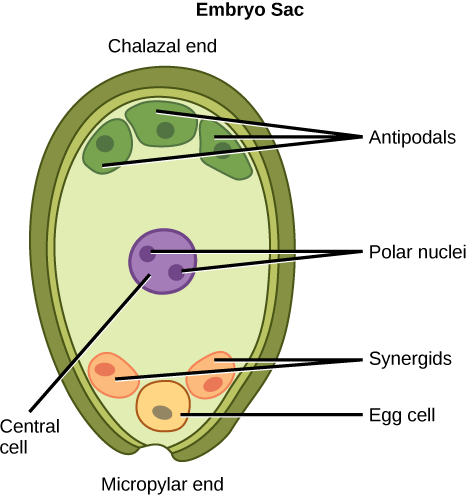
Equally shown in this diagram of the embryo sac in angiosperms, the ovule is covered by integuments (night dark-green) and has an opening called a micropyle. Inside the embryo sac are three antipodal cells, ii synergids, a key prison cell, and the egg cell. Prototype credit: OpenStax Biology.
Double Fertilization
The text below was adapted from Openstax Biology 32.2
The phenomenon of double fertilization, or two fertilization events, is unique to angiosperms and does not occur in any other blazon of plant or other organism.
As described above, after pollen is deposited on the stigma, information technology germinates and grows through the style to achieve the ovule. The pollen tube cell grows to form the pollen tube, guided to the micropyle by chemic signals from the synergid cells. The generative cell travels through the tube to the egg and divides mitotically to grade two sperm cells. One sperm fertilizes the egg cell, forming a diploid zygote; the other sperm fuses with the ii polar nuclei, forming a triploid cell that develops into the endosperm, which serves equally a source of nutrition for the developing embryo. Together, these ii fertilization events in angiosperms are known as double fertilization, illustrated below. Later on fertilization is consummate, no other sperm can enter. The fertilized ovule forms the seed, and the ovary become the fruit, usually surrounding the seed.
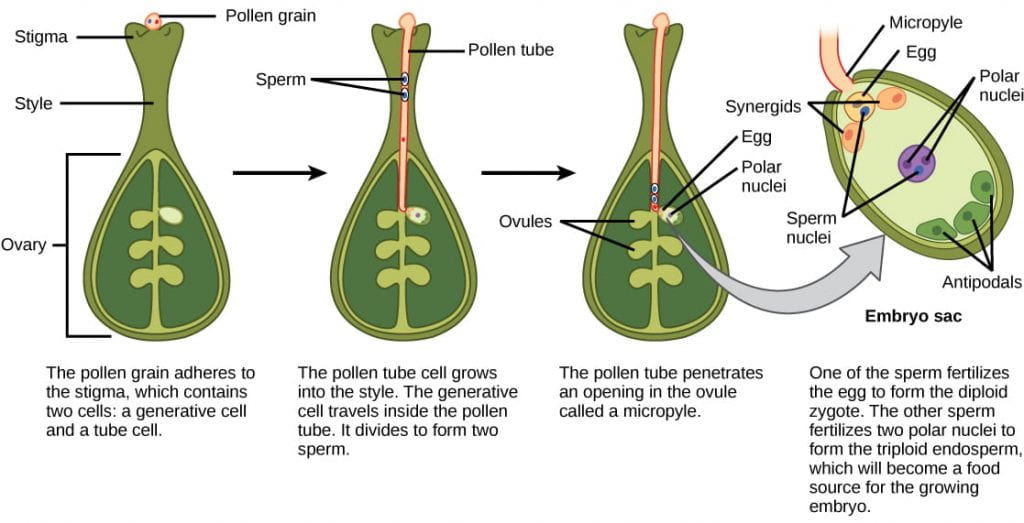
In angiosperms, one sperm fertilizes the egg to course the 2n zygote, and the other sperm fertilizes the central cell to form the triploid (3n) endosperm. This is called a double fertilization. Image credit: OpenStax Biological science
After fertilization, the zygote enters a temporary period of development (shown below). It offset divides to form 2 cells: the upper cell, or apical cell, and the lower cell, or basal jail cell. The division of the basal cell gives ascension to the suspensor, which eventually makes connection with the maternal tissue. The suspensor does not become function of the future plant, but instead provides a route for nutrition to be transported from the female parent establish to the growing embryo. In this way the suspensor is a type of "extra-embryonic" tissue and is coordinating to the umbilical string in placental mammals. The apical jail cell also divides, giving rise to the proembryo (the actual embryo that will develop into a institute). The endosperm accumulates starches, lipids, and proteins, and and so nourishes the developing cotyledons (embryonic leaves). The cotyledons will serve as an energy store for afterwards embryo development. The seed and then loses upwards to 95% of its water and embryonic development is suspended: the seed enters a catamenia of dormancy for dispersal, and growth is resumed only when the seed germinates. Once development is reactivated, the developing bulb will rely on the food reserves stored in the cotyledons until the first prepare of leaves begin photosynthesis.
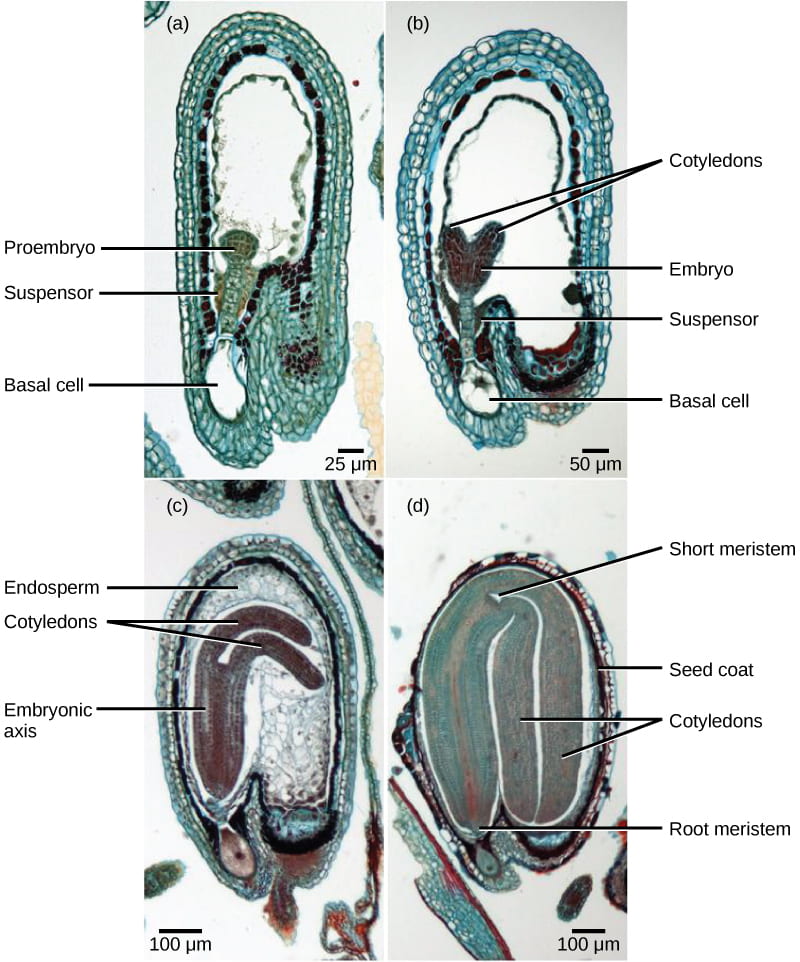
Shown are the stages of embryo development in the ovule of a shepherd's purse (Capsella bursa). After fertilization, the zygote divides to form an upper terminal jail cell and a lower basal cell. (a) In the first stage of development, the terminal cell divides, forming a globular pro-embryo. The basal cell besides divides, giving ascension to the suspensor. (b) In the 2nd stage, the developing embryo has a heart shape due to the presence of cotyledons. (c) In the 3rd stage, the growing embryo runs out of room and starts to bend. (d) Eventually, it completely fills the seed. (credit: OpenStax Biology, modification of piece of work past Robert R. Wise; calibration-bar data from Matt Russell)
The image below puts each of these steps in context with each other:
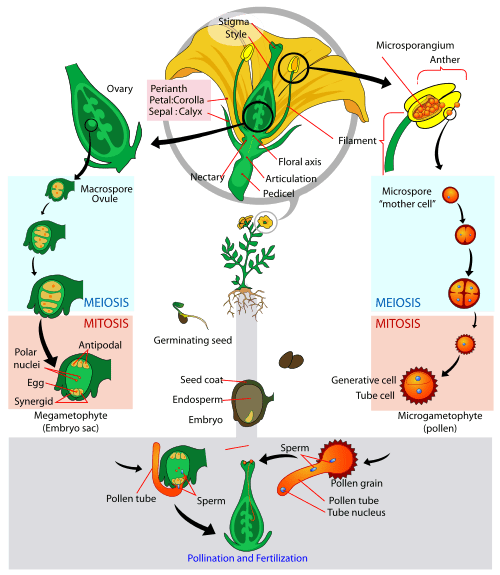
Image credit: LadyofHats Mariana Ruiz – based on Judd, Walter S. , Campbell, Christopher South. , Kellog, Elizabeth A. andStevens, Peter F. 1999. Plant Systematics: A PhylogeneticApproach.Sinauer Associates Inc.ISBN 0-878934049., Public Domain, https://commons.wikimedia.org/westward/index.php?curid=1671506
This video gives a simplified (just very engaging) overview of double fertilization, equally well as reviewing flower construction:
Avoiding self-pollination
In angiosperms, pollination is the transfer of pollen from an anther to a stigma. Many plants can both self-pollinate and cross-pollinate. Cocky-pollination occurs when the pollen from the anther is deposited on the stigma of the same bloom, or some other blossom on the same plant. Cross-pollination is the transfer of pollen from the anther of one flower to the stigma of another flower on a different individual.
Individuals who are well-adjusted to electric current conditions may not be well adapted if and when conditions change; therefore, genetic diversity is beneficial in changing environmental or stress weather (this is the principal reward of sexual reproduction, after all!). Although self-pollination less energetically demanding since it does non require product of nectar or extra pollen every bit nutrient for pollinators, self-pollination leads to less genetic diversity in the population since genetic material from the same constitute is used to form gametes, and eventually, the zygote. In contrast, cross-pollination (or out-crossing) leads to greater genetic multifariousness because the microgametophyte and megagametophyte are derived from dissimilar plants.
Because cross-pollination allows for more genetic diverseness, development has selected for many ways to avoid self-pollination in different species:
- The pollen and the ovary mature at different times
- The flowers have concrete features that prevent cocky-pollination, such differences in anther and stigma length
- Male person and female flowers located on different parts of the plant
- The male and female flowers are located on different plants, such that each plant makes only male or only female person gametophytes
- "Incompatibility genes" foreclose pollen from germinating into the stigma (illustrated beneath)

Self-incompatibility genes determine whether pollen can germinate, preventing fertilization by pollen with the same genotype.
Incompatibility genes are one of the more complex means that plants forbid self-pollination. Self-incompatibility is controlled by a gene chosen the S (sterility) locus. If the pollen and the stigma accept the aforementioned version (allele) of the gene, then then stigma sends signals that forbid the pollen from germinating.
Pollination Syndromes
Information technology may sound like a affliction, but pollination "syndrome" just means the way a particular found species is pollinated. The majority of pollinators are animals, including insects (similar bees, flies, and collywobbles), bats, or birds. Some institute species are pollinated by abiotic agents, such as wind and water. Plants that are pollinated past animals must either produce nectar to attract and feed the animals, or actress pollen that is eaten by the animals. Plants that are pollinated past wind or water must produce massive quantities of pollen since the probability of the pollen landing on a stigma of the right species is depression (current of air and h2o pollination is analogous to broadcast spawning). The mechanism of pollination and the features of the flower are tightly linked:
- Colored, highly scented flowers tend to be pollinated bybees,butterflies, wasps, orflies. These insects are active during the day, and are able to observe brilliant colors and have a potent sense of smell. Different smells attract different pollinators, with sweet smells attracting bees and butterflies, and rotting smells attracting flies. Many insect-pollinated flowers take additional color patterns in the UV range, which insects are capable of seeing while humans cannot.
- White or pale-colored, highly scented flowers tend to be pollinated bymothsand bats which are agile at nighttime. The light coloring makes them easier to run across at night, and they tend to aroma musky or fruity. Flowers pollinated by bats are larger than those pollinated by moths.
- Brightly colored, odorless flowers tend to be pollinated pastbirds, which practice not have a strong sense of smell. The flowers tend to take a curved, tubular shape to adapt the bird's neb.
- Small light-green, petal-less flowers tend to be pollinated bywind. Wind-pollinated flowers do non produce nectar, just must produce excessive quantities of pollen. Gymnosperms such as pines, which practise not have flowers, are also pollinated by wind.
- Some aquatic plants are pollinated by h2o; the pollen floats and the h2o carries it to some other flower.
Some examples of different pollination syndromes are shown below:

Left: Insects, such as bees, are important agents of pollination. Centre: Hummingbirds have adaptations that let them to reach the nectar of certain tubular flowers. Right: A person knocks pollen from a pine tree. (credit: OpenStax Biology, left: modification of work past Jon Sullivan, Lori Branham)
And this video briefly describes the different pollination syndromes listed above:
Seed Dormancy and Germination
As described above, a seed enters a flow of temporary development after fertilization; in most species, the seed then enters a menses of stasis (inactivity), called dormancy. Dormancy is triggered past loss of up to 95% of the seed'southward h2o content, which dehydrates the seed, causes extremely low metabolic action, and "concentrates" the seed's sugars to protect the cells from freezing during winter months. Dormancy can last months, years, or even centuries in some cases.
Once conditions are appropriate for bulb growth, the seed will thengerminate or re-initiate evolution. The bespeak to initiate seed germination is indicator that conditions are favorable for growth and, depending on the species, can include:
- water, indicating the start of the rainy flavour and rehyrdating the seed
- specific wavelengths of light, indicating favorable sunlight atmospheric condition necessary for photosynthesis and the seed is non buried too far under the soil
- a sustained period of common cold, indicating that the seed does not germinate until the cold flavor is over
- fire, typical of woods trees, indicating reduced competition from existing tall tree
- scarification, or chemic handling with acids, indicating that the seed has passed through the digestive tract of an animate being
Fruit and Seed Dispersal
After fertilization, the ovary of the flower develops into thefruit. While nosotros tend to retrieve of fruits as being sweetness, biologically a fruit is any structure that develops from an ovary after fertilization. The biological purpose of the fruit is southward eed dispersal, assuasive the seed to be spread far from the mother plant, and so they may find favorable and less competitive conditions in which to germinate and grow.
Some fruit have congenital-in mechanisms then they can disperse by themselves, whereas others require the help of agents similar air current, water, and animals. As with pollination syndromes and flower structure, you can often predict a fruit's dispersal machinery based on construction, limerick, and size:
- Propulsion-dispersed fruits, such as violets, actually "explode" out of the constitute.
- Wind-dispersed fruits, such every bit dandelions, are lightweight and may take wing or parachute-like appendages that allow them to be carried by the air current.
- H2o-dispersed fruits, such equally coconuts, are light or buoyant, giving them the ability to bladder.
- Beast-dispersedfruits may exist either have tiny "hooks" all over them then that they attach to passing animals and afterward fall off in a new location (like sandburs), or very sweet or fatty so that they volition be eaten and deposited in a new location in the feces (similar blackberries). Fruits dispersed by birds tend to exist brightly colored as birds have a highly developed sense of sight; fruits dispersed by mammals tend to exist highly scented equally mammals accept a highly developed sense of smell.

Fruits and seeds are dispersed by diverse means. (a) Dandelion seeds are dispersed past wind, the (b) kokosnoot seed is dispersed past water, and the (c) acorn is dispersed by animals that cache and then forget it. (credit OpenStax Biology a: modification of work by "Rosendahl"/Flickr; credit b: modification of work by Shine Oa; credit c: modification of work by Paolo Neo)
Source: https://organismalbio.biosci.gatech.edu/growth-and-reproduction/plant-reproduction/
0 Response to "What is the meaning of the term germinate? to start growth to make eggs to store food to make sperm"
Post a Comment